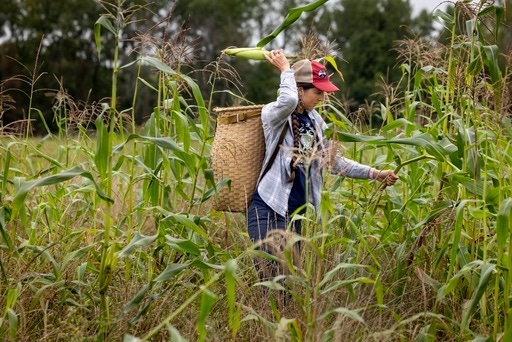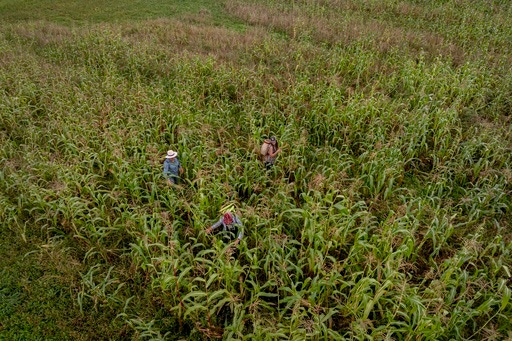Spring rains destroyed a harvest important to the Oneida people. Farmers are working to adapt

Lea Zeise, one of Ohe·laku's co-coordinators of the non-profit that works with the families planting crops, picks a cob of white corn in its early form known as green corn, during a harvest on the Oneida Indian Reservation on Friday, Aug. 30, 2024, in Oneida, Wis. (AP Photo/Mike Roemer)[ASSOCIATED PRESS/Mike Roemer]
This spring, a torrent of rain sent a river rushing over a field on the Oneida Nation in Wisconsin, destroying most of what was in its path, including the traditionally important crop of white corn.
Families tried planting a second time, but it was too wet; many seeds dissolved in the water-soaked soil. The corn that did sprout was patchy and stunted.
It looked “anemic,” said Lea Zeise, one of the coordinators of Ohe·láku, a non-profit that works with the families planting crops. “Really skinny and really frail.”
A few members picked what remained at the end of August in its early form, known as green corn, but it was barely enough to go around. There will be none of their white corn in the annual food boxes sent to tribal elders next year. And the harvest moon event, traditionally an important time for ceremonies and community gathering, has been canceled.
It’s a stark reminder of the uncertainty in store for Indigenous growers as the planet warms and as seasonal weather patterns become more unpredictable. There will likely be many hard years threatening the food that ties Oneida people to their culture, the land and each other. Oneida white corn stewards and other Indigenous growers want to adapt, and are proactively incorporating sustainable land management techniques like using cover crops to try to improve soil health and bolster their land against future droughts and floods. But years like this one remind them that it won’t always be enough.
“We’re really up against some pretty serious odds with climate change. There’s a lot at stake. And so it feels very personal,” Zeise said. “It’s very hard not to go out to the field and feel just deeply sad.”
______
EDITOR’S NOTE: This is part of a series of on how tribes and Indigenous communities are coping with and combating climate change.
______
White corn is more than just a food for Oneida people; it’s part of their creation story and a relative to be cared for. It’s also an annual, seasonal reason for people to come together, which was the philosophy behind Ohe·láku, which translates to “among the cornstalks.”
Braiding corn husks is the favorite activity of 10-year-old Lucia Stevens, who was crowned Lil’ Miss Oneida this year and whose Oneida name Tehwahshútyahks means “she breaks the night.” She’s been joining the white corn harvest for about as long as she can remember, but this was the hardest year she’s seen in her lifetime, her mother Stephanie said.
“We tried our best,” Lucia said. “The reason why we didn’t get that much corn is because it kept getting too hot days, and then it kept getting too rainy days, and it kept going back and forth like that.”
Zeise and her mother Laura Manthe, who helped found the organization, said that by growing corn communally, families can learn from each other. They can all chip in on the labor-intensive processes of sowing, weeding, picking cobs by hand, winnowing to separate the chaff from the grain and other tasks, Manthe and Zeise said. The group can also still have a substantial crop even if the animals get to some of it, and they have a better chance of surviving extreme weather events if they’re growing on a larger area of land.
But even growing together was no match for this year’s spring inundation. Drive around Wisconsin, Minnesota and Michigan and there are a lot of farmers “whose corn looks horrible,” Manthe said. But commercially grown corn, which uses more uniform varieties than heirloom ones and is often genetically modified, is looking pretty good this time of year, she said.
Oneida and commercial farmers take different approaches to dealing with smut, too — a type of fungus that can grow on corn. While many commercial growers consider it a disease to be eradicated, some Mexican growers use it for cooking and consider a delicacy. Ohe·láku members have taken inspiration and are just starting to use it as the wetter seasons make it more prevalent, but by this time the corn smut is already too mature to use.
Becky Webster, who grows with Ohe·láku, is also executive director of another Oneida farmstead and non-profit Ukwakhwa, where she plants white corn in smaller plots and in two different ways. Some of it she plants in rows, and some of it in a method called Three Sisters, where corn, beans and squash are all planted together in mounds. She said the Three Sisters corn wasn’t flooded out because it was protected by the mounds, but that an unseasonably late wind storm blew over many of the stalks. She thinks it’s still salvageable but not in a great position. And she can’t remember ever seeing weather this wild.
“Our springs were pretty steady before, aside from storms here and there. But we’ve had to deal with extremes. Last year was extreme drought and this year was extreme rain,” Webster said. She added that it’s harder to anticipate which planting methods might be most effective, and described how it’s been a challenge to save seeds strategically because the ones that did well in a wet year won’t do as well in a dry year and vice versa.
All the Oneida growers stressed the importance of leaning on traditional farming knowledge, of further importance because many tribal members have been cut off from their own culture. It’s a way of returning to their roots after families lost land to colonizers, children were forced to attend boarding schools and land was leased or sold to non-Indigenous farmers. But reviving past knowledge is made harder by the new seasonal unpredictability.
“Even if we did know everything our ancestors learned, we’re having to do it in an erratic and changing climate,” Webster said.
University of Wisconsin-Madison Ph.D. candidate Daniel Hayden thinks more research will be needed to understand the science behind sustainable Indigenous farming techniques that go back generations. He’s been working with Ohe·láku for several years now trialing sustainable methods like interseeding cover crops, which involves planting other crops in the same field to improve soil health, balance moisture levels and prevent erosion. It’s a work in progress, and this year it wasn’t enough to keep the majority of the corn from getting washed out, though his research plot of white corn did make it.
He acknowledged that while Oneida growers are willing to focus on stewarding land and improving soil health — not necessarily maximizing yields — commercial farmers have different priorities. He hopes his research will amplify the conversation about including Indigenous practices in mainstream agriculture, something he doesn’t think has gotten enough attention yet.
As Webster put it, “The Indigenous practices are no longer plan B, it has to be the plan. Because we are very mindful of all of the things around us.”
___
Follow Melina Walling on X at @MelinaWalling.
___
The Associated Press’ climate and environmental coverage receives financial support from multiple private foundations. AP is solely responsible for all content. Find AP’s standards for working with philanthropies, a list of supporters and funded coverage areas at AP.org.
Copyright 2024 The Associated Press. All rights reserved. This material may not be published, broadcast, rewritten or redistributed without permission.
